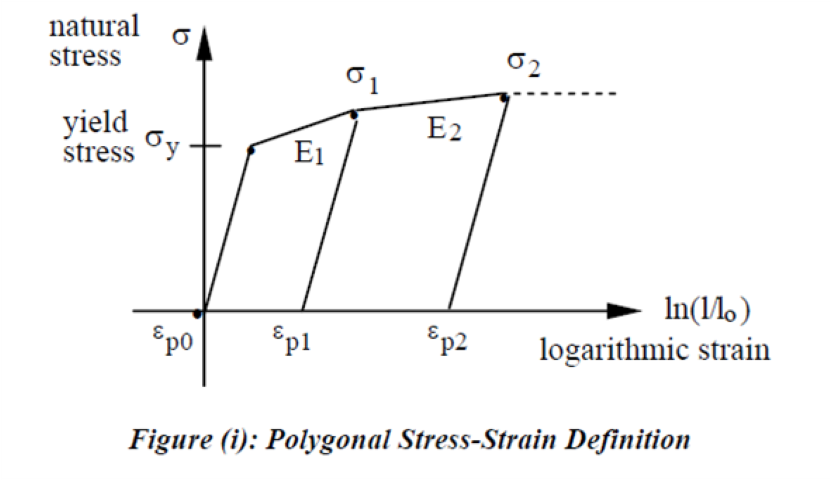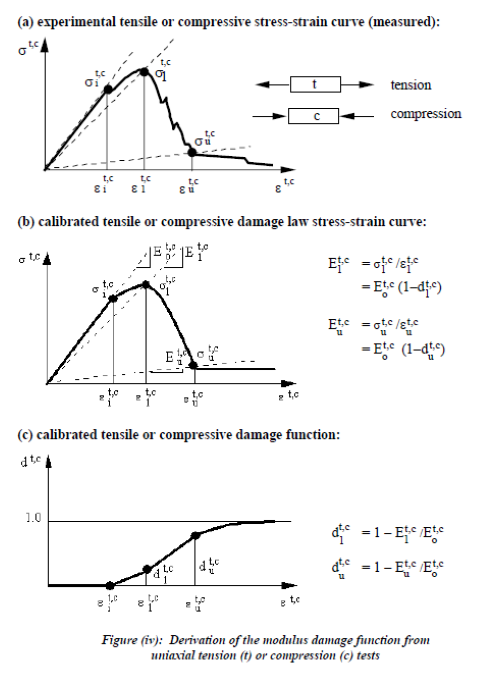| postFailure Element |
This type describes the post failure behaviour of the material.
Namespace: Empty
Schema: Empty
| Name | Occurrences | Description |
|---|---|---|
| | [0, 1] | name of the post failure definition |
| | [0, 1] | description of the post failure definition |
| | [0, 1] | name of material law |
| | ||
| | b.) Option 2: Composite damage law (UD bi-phase model (PLY 0), PAM-CRASH) The data may be used to describe the failure and post failure behavior of composite ply materials according to the so-called UD bi-phase ply model implemented in the explicit FE code PAM-CRASH. The data describe the shear damage behavior in the matrix phase (degenerated bi-phase model, see PAM-CRASH Solver Reference Manual., PLY type 0) The parameters describe the failure and post failure behavior of composite ply materials according to the so-called UD bi-phase ply model implemented in the explicit FE code PAM-CRASH. The data describe the shear damage behavior in the matrix phase (degenerated bi-phase model, see PAM-CRASH Solver Reference Manual., PLY type 0) | |
| | doubleBaseType | |
| | doubleBaseType | |
| | doubleBaseType | |
| | doubleBaseType | |
| | doubleBaseType | |
| | Plastification curve incl. element elimination (isotropic materials) The data may be used to describe the plastic behavior of isotropic materials in non-linear analysis, such as crash simulations. The input is defined according to the needs of Material 103 (single stress strain option) in the PAM-CRASH explicit Finite Element code, but can also be used for equivalent material laws in alternative simulation environment (see PAM-CRASH Solver Reference Manual., Material 103) | |
| | [0, 1] | plasticEliminationStrain [-] Plastic strain for element elimination during the non-linear analysis |
| | [0, *] | plasticityCurvePointType |
| Name | Type | Required | Description |
|---|---|---|---|
There are 2 options for post failure description:
- Plastification curve incl. element elimination (isotropic materials)
- Composite damage law (UD bi-phase model (PLY 0), PAM-CRASH)
Option 1: Plastification curve incl. element elimination (isotropic materials) The data may be used to describe the plastic behavior of isotropic materials in non-linear analysis, such as crash simulations. The input is defined according to the needs of Material 103 (single stress strain option) in the PAM-CRASH explicit Finite Element code, but can also be used for equivalent material laws in alternative simulation environment (see PAM-CRASH Solver Reference Manual., Material 103)

Source: PAM-CRASH V2010 - Reference Manual
Option 2: Composite damage law (UD bi-phase model (PLY 0), PAM-CRASH) The data may be used to describe the failure and post failure behavior of composite ply materials according to the so-called UD bi-phase ply model implemented in the explicit FE code PAM-CRASH. The data describe the shear damage behavior in the matrix phase (degenerated bi-phase model, see PAM-CRASH Solver Reference Manual., PLY type 0)

Source: PAM-CRASH V2010 - Notes Manual